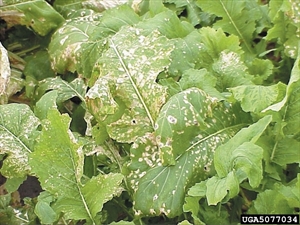Cabbage light leaf spot, frog-eye leaf spot
Pacific Pests, Pathogens, Weeds & Pesticides - Online edition
Pacific Pests, Pathogens, Weeds & Pesticides
Cabbage light leaf spot (302)
Cercospora brassicicola
In tropical and sub-tropical countries. It is recorded from Australia, Niue, Papua New Guinea, Solomon Islands, and Vanuatu.
Plants in the cabbage family (Brassicaeae), particularly, Chinese cabbage, cauliflower, turnip, mustard, and to a lesser extent cabbage.
Leaf spots round to angular, up to 8 mm diameter, pale brown or white with a dark brown margin (Photos 1&2).
Spread is in rain and wind, and survival is in trash, on volunteer plants, weeds and seed. In general, it is a disease favoured by wet conditions, and cool temperatures, less than 20°C.
Although a common disease, its impact is low as it is mainly a disease of mature leaves. Only occasionally does defoliation occurs.
Look for the round to angular, pale brown, grey or white spots, with a dark border, less than 1 cm across.
CULTURAL CONTROL
Before planting:
-
Use certified seed or, if not available, treat with a fungicide (see below).
-
Grow seedlings in soilless or pasteurized media in clean trays. Check regularly for signs of disease, and discard any plants with symptoms.
-
Remove volunteer plants.
- Avoid overlapping crops, preventing spores from older crops infecting newer ones. If not possible, then plant newer crops far from those established already.
During growth:
After harvest:
-
Remove the remains of the crop after harvest, and destroy. Note, infections on the leaves produce spores until the leaves are completely decomposed. Alternatively, plough in the remains as deeply as possible.
-
Rotate crops, leaving a 2-3-year interval between crops of cabbages (and related crops) planted on the same land.
CHEMICAL CONTROL
-
Seed treatment: Treat the seed with captan, thiram or mancozeb.
-
In the field: Use the fungicides recommended against Alternaria leaf spot (see Fact Sheet no. 133): chlorothalonil, copper formulations, mancozeb, and members of the strobilurin group.
____________________
When using a pesticide, always wear protective clothing and follow the instructions on the product label, such as dosage, timing of application, and pre-harvest interval. Recommendations will vary with the crop and system of cultivation. Expert advice on the most appropriate pesticides to use should always be sought from local agricultural authorities.
AUTHORS Grahame Jackson & Eric McKenzie
Information from Smith S (2012) Diseases of turnip and mustard greens, Division of Agriculture, Research & Extension, University of Arkansas System. (https://www.uaex.edu/publications/pdf/FSA-7549.pdf); and from Bost S (2013) Disease control in leafy brassica greens. University of Tennessee. (https://ag.tennessee.edu/EPP/Documents/Disease%20Control%20in%20Leafy%20Brassica%20Greens.pdf). Photo 1 Clemson - USDA Cooperative Extension Slide Series, Bugwood.org. Photo 2 David B. Langston, University of Georgia, Bugwood.org.
Produced with support from the Australian Centre for International Agricultural Research under project PC/2010/090: Strengthening integrated crop management research in the Pacific Islands in support of sustainable intensification of high-value crop production, implemented by the University of Queensland and the Secretariat of the Pacific Community.





